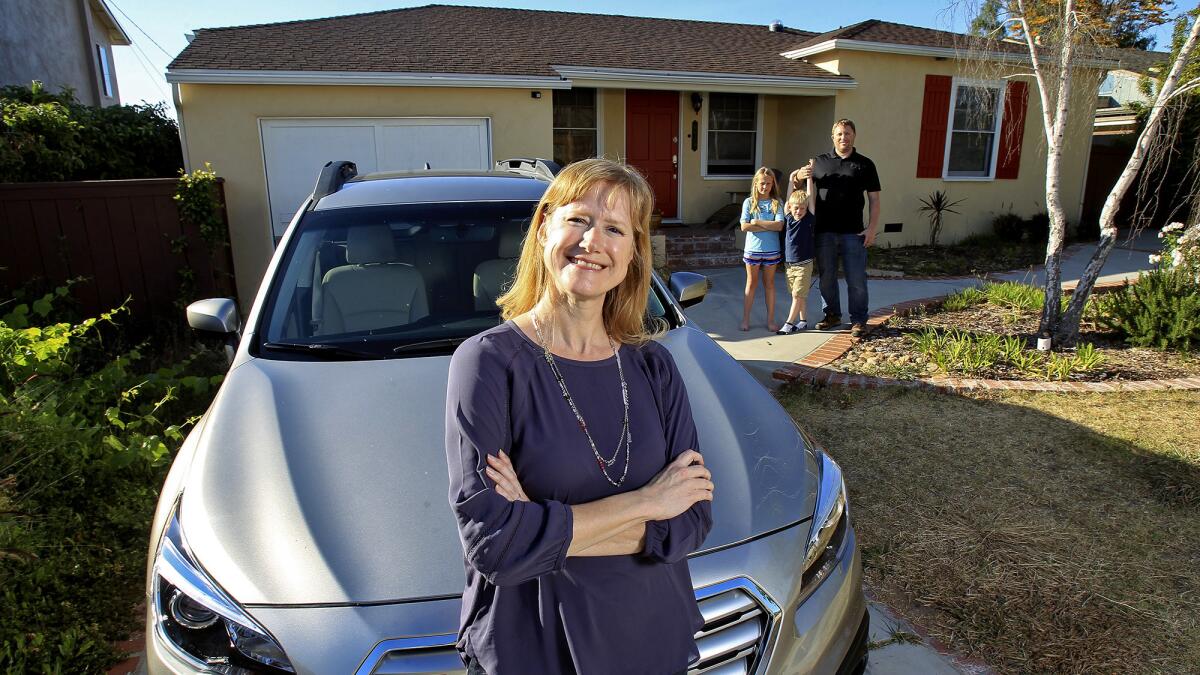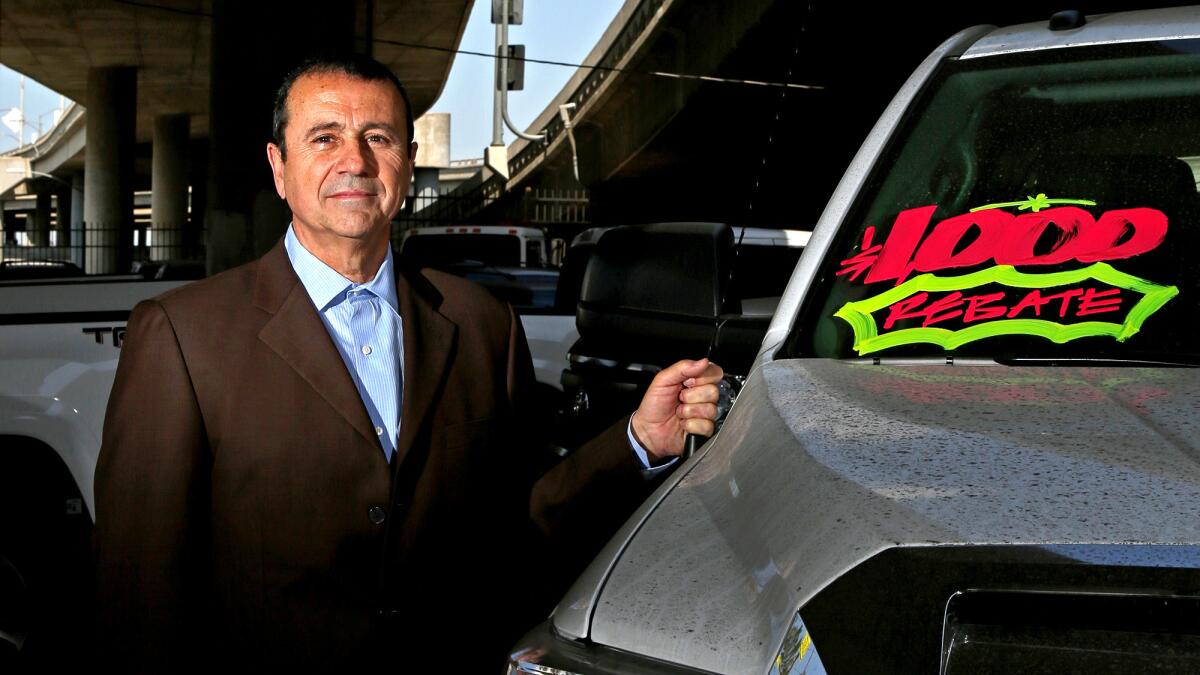As auto sales cool, there are great deals to be had — and worries of a lending bubble

- Share via
Heather Milne Barger and her husband knew it was about time to replace their 12-year-old Honda Civic hybrid this year — not only because it was showing its age, but because they knew there were bargains to be had.
“There were a lot of deals that dealerships were having, and cheap financing,” said Milne Barger, 44.
Sure enough, when the La Mesa couple bought their new Subaru Outback in February, the dealership knocked $2,300 off the $29,400 list price — and offered them a no-interest loan.
Indeed, there’s rarely been a better time to buy a car or truck.
New-vehicle sales have set records in each of the last two years — juiced by continuing low interest rates, incentives and generous lending practices.
Now, America is awash in cars and trucks, and sales are on track to decline this year for the first time since the recession.
That means manufacturers and lenders will have to make sales and loan terms even more attractive than they have been if they want to maintain volume.
Carlos Badosa has sold cars at Toyota dealerships for almost 40 years, through boom times and lean years, but he’s never quite seen deals like he has lately.
Over the last few months, the Japanese carmaker has begun offering rebates of at least $2,000 on every model — and twice that amount for some slower selling sedans.
“That’s unheard of,” said Badosa, 62, finance director at Toyota of Downtown L.A., who expects the deals might get even sweeter.
“I think inventories are very, very high. They have a whole lot of cars,” he said. “They need to get somebody to buy them. ”
The Bargers have excellent credit, but car dealers and lenders have also been luring buyers with spottier credit records. And the results have been predictable.
A growing number of loans have been issued to subprime borrowers over the last few years and they’ve started to go bad at rates not seen since the recession.
“It raises the question: How does this end?” said Moody’s rating analyst Jason Grohotolski. “I feel like we’re at an inflection point, and it’s hard to tell at the moment whether discipline will prevail or loosening will continue.”

At his downtown Toyota dealership, Badosa has noticed not only sweeter incentives, but also plenty of easy credit offered by lenders, including Toyota’s in-house financing arm, as well as credit unions and specialty finance companies.
Lenders increasingly have been willing to make loans to customers who have limited credit histories. They’re also more willing to offer longer terms.
At the beginning of 2010, the average auto loan in the U.S. lasted 62 months. By the end of last year, the average had risen to 68, or more than 5½ years, according to Moody’s research.
And 32% of loans had terms of longer than six years — up from 29% just a year earlier. Longer terms allow buyers to lower monthly payments, or to buy more expensive vehicles.
Badosa has even seen an uptick in seven-year loans that carry higher rates of interest.
“It’s still a small percentage, but it’s getting more common,” he said. “I don’t like it. It doesn’t do the customer any good, but when people want a car bad enough ... we’ll find a way to get it for you.”
The last several years have already seen a big increase in auto lending, including subprime lending.
At the end of last year, Americans owed about $1.2 trillion in auto loan debt, a record amount, and car loans now represent more of total household debt — 9.2% — than they have since the end of 2002.
Roughly a quarter of that debt is owed by borrowers with subprime credit scores, according to the Federal Reserve Bank of New York and credit bureau Equifax. Although that’s a smaller percentage of overall auto debt than during the run-up to the recession, it’s a record amount. And a growing number are falling behind on their loans.
Two percent of subprime auto loan borrowers were more than 90 days behind — considered seriously delinquent — in the third quarter, up from 1.4% at the end of 2012, according to the New York Fed.
As those borrowers drive up delinquency rates overall, some lenders, especially banks, have tightened their credit standards, requiring higher scores and larger down payments. But others, particularly finance companies that specialize in loans to subprime borrowers, are moving in the opposite direction.
Paul Kerwin, chief financial officer of Westlake Financial Services, a Mid-Wilshire auto lender that specializes in high-interest loans to customers with weak credit, said many of Westlake’s competitors have been too willing to offer risky loans.
Instead of Westlake’s typical loans for $10,000 or $12,000 that are paid off in four years or so, some lenders are offering much larger loans and longer terms.
“When lenders loosen, you get a $20,000 loan and a 72-month term, and now that’s just coming back to bite everyone,” Kerwin said. “A lot of it is putting a customer in too much car.”
In December, the average new car sold for a record $35,309, an increase of nearly $1,000 over the average paid in December 2014, according to auto information provider Kelley Blue Book. The firm cited a sudden shift toward trucks and sport utility vehicles as the key factor driving up prices.
That has given rise to a worrisome trend: Americans are trading in their cars for less than they still owe on their car loans.
Now, they need loans to cover the cost of their new vehicle and the remainder of what they owed.
Ivan Drury, an analyst at Santa Monica car-buying site Edmunds.com, found that in the first two months of this year, about 33% of new-car buyers who made a trade-in were underwater, owing an average of $5,195 more than their old vehicle’s trade-in value. That’s the highest percentage and dollar figure on record.
“People who are trading in these cars, they’ll either have to pay off their last car loan on the spot, or they’re going to tack another $5,000 on to a $34,000 car loan,” said Drury, who suspects these customers are indulging desires rather than filling needs. ”You’re seeing some wild behavior.”
There’s an added wrinkle. All these years of new-car sales have dumped millions of vehicles into the used-car market, leading to a steep decline in used-car values.
According to data compiled by Edmunds.com, 3-year-old compact cars sold in early 2014 fetched an average of $12,194. In the first two months of this year, 3-year-old compacts were selling for an average of $11,173.
That’s part of what’s pushing carmakers to offer generous incentives on new cars, but it could be a problem for buyers hoping to trade in a car. It’s also problematic for lenders: When borrowers default and lenders repossess and resell their vehicles, lenders can expect to take bigger losses.
Despite all that, investors continue to pile in to bonds backed by auto loans, including subprime debt, ensuring a steady supply of capital for more new loans.
Steven Wald, an analyst at downtown L.A. investment firm DoubleLine Capital, said that while delinquencies have risen, bonds backed by auto loans remain attractive because of low yields on other investments.
“The market has taken the recent headlines in stride,” Wald said. “Recent deals have been oversubscribed. There’s no shortage of demand from an investor point of view.”
Wald said DoubleLine, which manages more than $100 billion in assets, has invested only in the most senior types of auto-loan-backed bonds — ones that are repaid first and are therefore less likely to be affected by defaults.
Still, the uptick in delinquencies on subprime auto loans has stoked fears of a bust akin to the subprime mortgage meltdown.
“What is happening in this space today reminds me of what happened in mortgage-backed securities in the run-up to the crisis,” Thomas Curry, the nation’s top bank regulator, said in an October 2015 speech. “Although delinquency and losses are currently low, it doesn’t require great foresight to see that this may not last.”
But some investors and analysts say it’s not a good comparison. Even with auto debt at a record high of $1.2 trillion, that still represents less than 10% of overall household debt. Americans owe more in student loans, and both of those types of debt are dwarfed by the $8.5 trillion Americans owe on their houses.
What’s more, when Americans were taking out risky home loans before the recession, many were assuming they’d be able to sell for a profit in a few years or refinance once their home gained value. That kind of speculative behavior doesn’t happen with cars and truck loans, which most buyers intend to pay off.
Cars also are necessities for many Americans.
A study by credit bureau TransUnion found that between 2004 and 2013, Americans who had a mortgage, a credit card and an auto loan paid their auto loans most often, with the other two types of debt fighting for second priority.
The lending industry has an oft-repeated and crass explanation for this: “You can sleep in your car, but you can’t drive your house to work.”
Some in the industry, including the National Auto Dealers Assn., expect auto sales to stay strong this year. The association estimates sales of 17.1 million new cars and trucks this year — down from 17.5 million last year, but still a historically high figure.
Others, though, say a more significant slowdown is almost inevitable. Mark Wakefield, an auto industry analyst at consulting firm Alix Partners, expects an annual sales decline of 15% to 20% from last year’s peak by 2019.
“This is a cyclical market. It’s always been a cyclical market,” Wakefield said. “The idea that we’re going to plateau, to us it doesn’t really hold water.”
Auto sales have more or less plateaued before, about a decade ago, but Wakefield said U.S. automakers were only able to make that happen by offering massive incentives that cut into profitability. He doesn’t expect them to accept dramatically lower profits this time around.
A decade ago, the automakers had more overhead, more workers, more pension obligations and factories that were less flexible, making it hard to accept lower sales, said Matthew Stover, an auto industry analyst at Susquehanna Financial Group. But after the federal bailouts, bankruptcies and corporate rejiggerings, the automakers aren’t as dependent on keeping up that volume.
“They don’t have these massive, unfunded liabilities that they just have to fund,” Stover said. “In 2004, Ford didn’t have a choice. They couldn’t say ‘No mas.’ But they can in 2017.”
Follow me: @jrkoren
More to Read
Inside the business of entertainment
The Wide Shot brings you news, analysis and insights on everything from streaming wars to production — and what it all means for the future.
You may occasionally receive promotional content from the Los Angeles Times.











